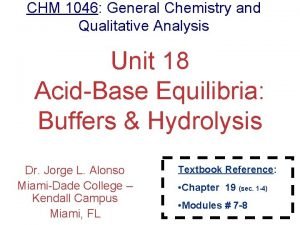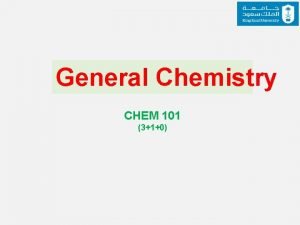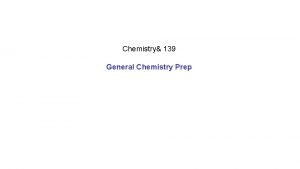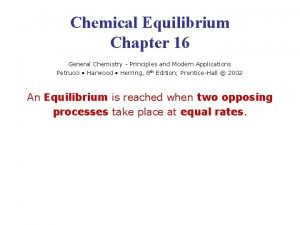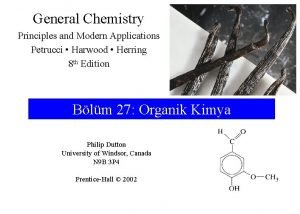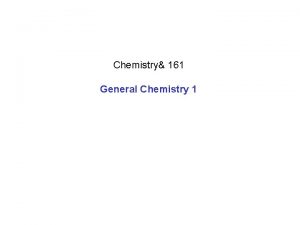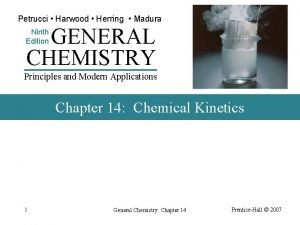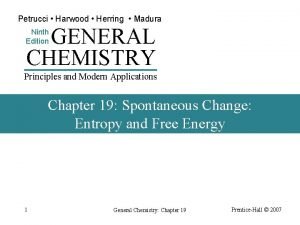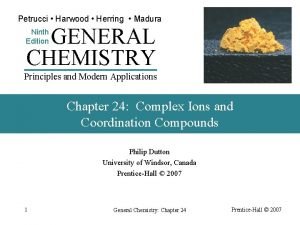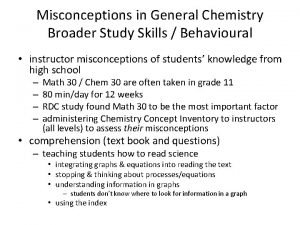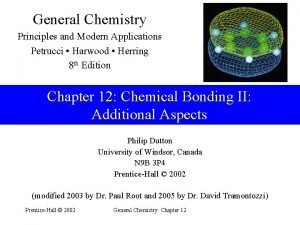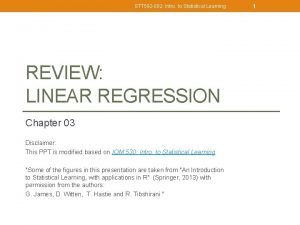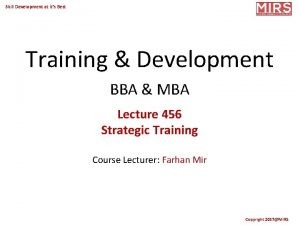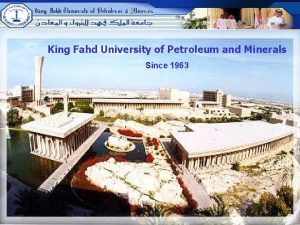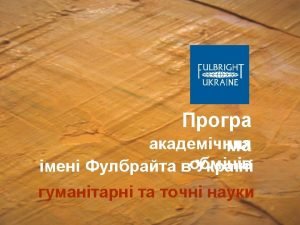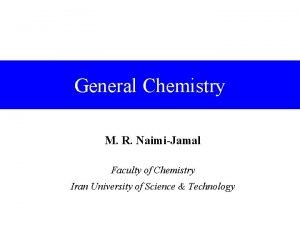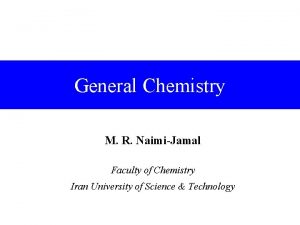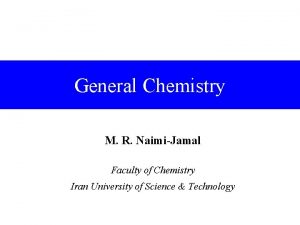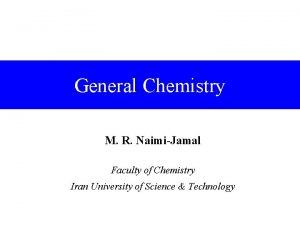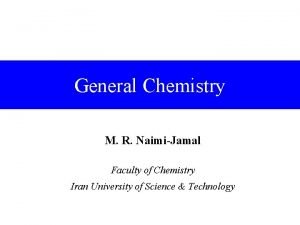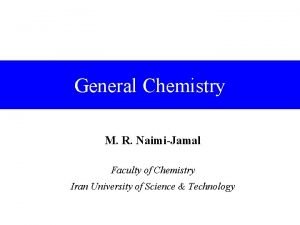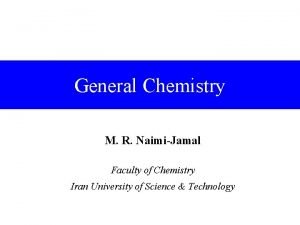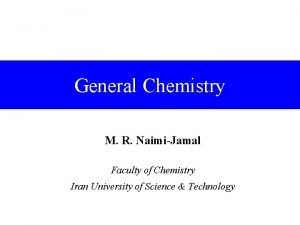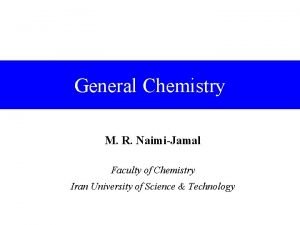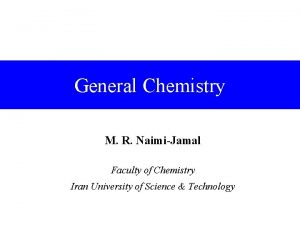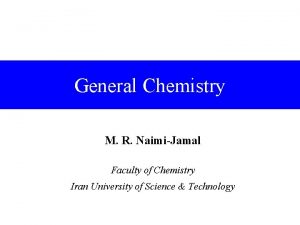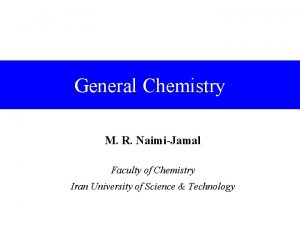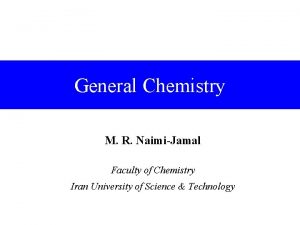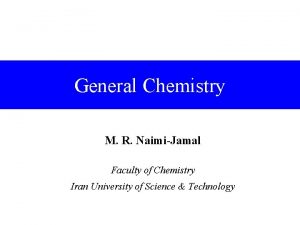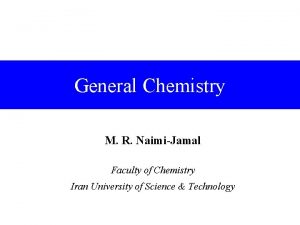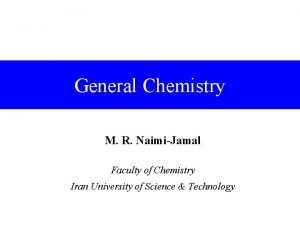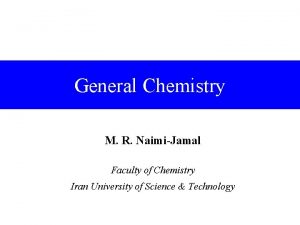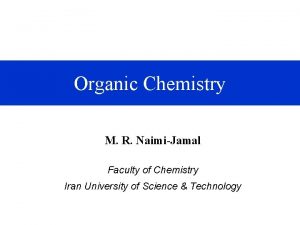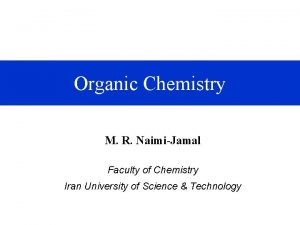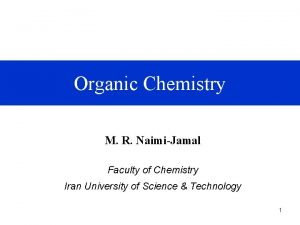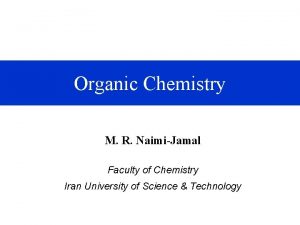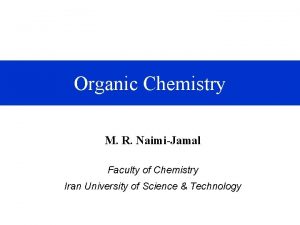General Chemistry M R NaimiJamal Faculty of Chemistry































































![Example: Aluminum Concentration: 0. 0165 mol Al 2(SO 4)3 2 mol Al 3+ [Al] Example: Aluminum Concentration: 0. 0165 mol Al 2(SO 4)3 2 mol Al 3+ [Al]](https://slidetodoc.com/presentation_image_h/cc77e0ede4abc8b60025501a409c0c72/image-64.jpg)





- Slides: 69

General Chemistry M. R. Naimi-Jamal Faculty of Chemistry Iran University of Science & Technology


Contents 4 -1 4 -2 4 -3 4 -4 Chemical Reactions and Chemical Equations and Stoichiometry Chemical Reactions in Solution Determining the Limiting reagent

4 -1 Chemical Reactions and Chemical Equations As reactants are converted to products, we observe: – Color change – Precipitate formation – Gas evolution – Heat absorption or evolution Chemical evidence may be necessary.

Formation of Al. Br 3

Chemical Reaction Nitrogen monoxide + oxygen → nitrogen dioxide Step 1: Write the reaction using chemical symbols. Step 2: Balance the chemical equation. 2 NO + O 1 2 → NO 2 2

Molecular Representation

Balancing Equations Example: Nitrogen monoxide + oxygen → nitrogen dioxide • Never introduce extraneous atoms to balance. NO + O 2 → NO 2 + O • Never change a formula for the purpose of balancing an equation. NO + O 2 → NO 3

Balancing Equation Strategy • Balance elements that occur in only one compound on each side first. • Balance free elements last. • Balance unchanged polyatomics as groups. • Fractional coefficients are acceptable and can be cleared at the end by multiplication.

Chemical Equations • The physical states: – Solid (s) – liquid (l) – gas (g) – and aqueous (aq) P 4 (s) + 6 Cl 2 (g) 4 PCl 3 (l)

4 -2 Chemical Equations and Stoichiometry • Stoichiometry includes all the quantitative relationships involving: – atomic and formula masses – chemical formulas. – The coefficients in front of the compounds in a balanced equation are called stoichiometric coefficients • Mole ratio is a central conversion factor.

Mass Relationships P 4 + 6 Cl 2 4 PCl 3 Initial amount (mol) 1. 00 mol (124 g) 6. 00 mol (425 g) 0 mol (0 g) Change in amount (mol) - 1. 00 mol -6. 00 mol +4. 00 mol (0 g) 4. 00 mol (549 g) After complete 0 mol (0 g) reaction (mol) From this we can calculate mass of one compound required to complete the reaction if the mass of the other compound is given

Example 4 -3 Relating the Numbers of Moles of Reactant and Product. How many moles of H 2 O are produced by burning 2. 72 mol H 2 in an excess of O 2? Write the Chemical Equation: Balance the Chemical Equation: 2 H 2 + O 2 → H 2 2 O Use the stoichiometric factor or mole ratio in an equation: n. H 2 O = 2. 72 mol H 2 × 2 mol H 2 O = 2. 72 mol H 2 O 2 mol H 2

Example 4 -6 Additional Conversion Factors in a Stoichiometric Calculation: Volume, Density, and Percent Composition. An alloy used in aircraft structures consists of 93. 7% Al and 6. 3% Cu by mass. The alloy has a density of 2. 85 g/cm 3. A 0. 691 cm 3 piece of the alloy reacts with an excess of HCl(aq). If we assume that all the Al but none of the Cu reacts with HCl(aq), what is the mass of H 2 obtained?

Example 4 -6 Write the Chemical Equation: Balance the Chemical Equation: 2 Al + HCl → Al. Cl 6 2 3 + H

Example 4 -6 2 Al + 6 HCl → 2 Al. Cl 3 + 3 H 2 Plan the strategy: cm 3 alloy → g Al → mole Al → mol H 2 → g H 2 We need 5 conversion factors! Write the Equation and Calculate: 97. 3 g Al × m. H = 0. 691 cm 3 alloy × 2. 85 g alloy × 2 100 g alloy 1 cm 3 1 mol Al × 3 mol H 2 × 2. 016 g H 2 = 0. 207 g H 2 2 mol Al 26. 98 g Al 1 mol H 2

Combustion Reactions • Combustion reaction – burning of a substance. Substance combines with oxygen to form carbon dioxide and water • C 8 H 18 (l) + O 2(g) CO 2(g) + H 2 O (l)

Balancing Combustion Reactions 1. Write correct formulas for the reactants and products 2. Balance the carbon atoms 3. Balance the hydrogen atoms 4. Balance the oxygen atoms 5. Verify that the number of atoms of each element is balanced

Example 4 -2 Writing and Balancing an Equation: The Combustion of a Carbon-Hydrogen-Oxygen Compound. Liquid triethylene glycol, C 6 H 14 O 4, is used a a solvent and plasticizer for vinyl and polyurethane plastics. Write a balanced chemical equation for its complete combustion.

Example 4 -2 Chemical Equation: 15 → CO C 6 H 14 O 4 + O 6 7 6 2 + H 2 O 2 2 1. Balance C. 2. Balance H. 3. Balance O. 4. Multiply by two 2 C 6 H 14 O 4 + 15 O 2 → 12 CO 2 + 14 H 2 O and check all elements.

Yields • Theoretical yield – the maximum amount of product that can be formed from a chemical reaction • Actual yield – the amount of product that is formed in the laboratory




Theoretical, Actual and Percent Yield • When actual yield = % 100, then the reaction is said to be quantitative. • Side reactions reduce the percent yield. • By-products are formed by side reactions.

Limiting Reagents • The goal of chemical reactions is to produce the highest amount of product possible – So, one reagent will probably be in excess – This allows for the complete reaction of one reagent, even though some others remain unreacted (NH 4)2 Pt. Cl 4(s) + 2 NH 3(aq) 2 NH 4 Cl(aq) + Pt(NH 3)2 Cl 2(s) $100/g $0. 01/g All of the expensive reagent is used up, leaving the cheap unreacted ammonia







Limiting Reagent

Chemical Equations & Chemical Analysis • Analytical chemists try to identify substances in a mixture, and try to measure the quantities of the components. • Mostly it is done with instrumental methods • It is essential to use chemical reactions and stoichiometry

Quantitative Analysis of a Mixture • Usually depends on one of the two following ideas. Idea 1: –A substance, present in unknown amount, can be allowed to react with a known quantity of another substance. If the stoichiometric ratio for their reaction is known, the unknown can be determined. CH 3 CO 2 H(aq) + Na. OH(aq) Na. CH 3 CO 2(aq) + H 2 O(l) Know the amount of Na. OH so we can determine the amount of acetic acid

Quantitative Analysis of a Mixture Idea 2 – A material of unknown composition can be converted to one or more substances of known composition. Those substances can be identified, their amounts determined, and these amounts related to the amount of the original, unknown substance. C 7 H 5 NO 3 S + X convert to SO 42 - Na 2 SO 4 + other Na 2 SO 4(aq) + Ba. Cl 2(aq) Ba. SO 4(s) + 2 Na. Cl(aq) 1 mol Na 2 SO 4 1 mol SO 42 - 1 mol Ba. SO 4

Chemical Reactions in Solution • Close contact between atoms, ions and molecules necessary for a reaction to occur. • Solvent – We will usually use aqueous (aq) solution. • Solute – A material dissolved by the solvent.


Molarity # Mole of solute Molarity (M) = Volume of solution (L) If 0. 444 mol of urea is dissolved in enough water to make 1. 000 L of solution the concentration is: curea = 0. 444 mol urea = 0. 444 M CO(NH 2)2 1. 000 L



Preparation of a Solution Weigh the solid sample. Dissolve it in a volumetric flask partially filled with solvent. Carefully fill to the mark.

Example 4 -6 Calculating the mass of solute in a solution of known molarity. We want to prepare exactly 0. 2500 L (250 m. L) of an 0. 250 M K 2 Cr. O 4 (MW=194. 02) solution in water. What mass of K 2 Cr. O 4 should we use? Plan strategy: Volume → moles → mass We need 2 conversion factors! Write equation and calculate: m. K 0. 250 mol× 194. 02 g = 12. 1 g = 0. 2500 L × 2 Cr. O 4 1. 00 mol 1. 00 L

Solution Dilution Mi × Vi Mf × Vf n M = V Mi × Vi = nf = Mf × Vf Mf = Mi × Vi Vf = Mi Vi Vf

Example 4 -10 Preparing a solution by dilution. A particular analytical chemistry procedure requires 0. 0100 M K 2 Cr. O 4. What volume of 0. 250 M K 2 Cr. O 4 should we use to prepare 0. 250 L of 0. 0100 M K 2 Cr. O 4? Plan strategy: Vi Mf = Mi Vf Vi = Vf Mf Mi Calculate: VK 0. 0100 mol 1. 000 L = 0. 2500 L × = 0. 0100 L 2 Cr. O 4 0. 250 mol 1. 00 L

Solution formation by Dilution

Oxidation States Metals tend to lose electrons. Non-metals tend to gain electrons. Na Na+ + e- Cl + e- Cl- We use the Oxidation State to keep track of the number of electrons that have been gained or lost by an element.

Rules for Oxidation States 1. The oxidation state (OS) of an individual atom in a free element is 0. 2. The total of the OS in all atoms in: i. Neutral species is 0. ii. Ionic species is equal to the charge on the ion. 3. In their compounds, the alkali metals and the alkaline earths have OS of +1 and +2 respectively. 4. In compounds the OS of fluorine (F) is always – 1

Rules for Oxidation States 5. In compounds, the OS of hydrogen (H) is usually +1 6. In compounds, the OS of oxygen (O) is usually – 2. 7. In binary (two-element) compounds with metals: i. Halogens have OS of – 1, ii. Group 6 A have OS of – 2 and iii. Group 5 A have OS of – 3.

Example: Assigning Oxidation States. What is the oxidation state of the underlined element in each of the following? a) P 4; b) Al 2 O 3; c) Mn. O 4 -; d) Na. H a) P 4 is an element. P OS = 0 b) Al 2 O 3: O is – 2. O 3 is – 6. Since (+6)/2=(+3), Al OS = +3. c) Mn. O 4 -: net OS = -1, O 4 is – 8. Mn OS = +7. d) Na. H: net OS = 0, rule 3 beats rule 5, Na OS = +1 and H OS = -1.

Naming Compounds Trivial names are used for common compounds. A systematic method of naming compounds is known as a system of nomenclature. Inorganic compounds Organic compounds

Inorganic Nomenclature Binary Compounds of Metals and Nonmetals: first the name of the metal, then of the non-metal Na. Cl = electrically neutral sodium chloride name is unchanged + “ide” ending Mg. I 2 = magnesium iodide Al 2 O 3 = aluminum oxide Na 2 S = sodium sulfide


Binary Compounds of Two Non-metals Molecular compounds usually write the positive OS element first. HCl hydrogen chloride Some pairs form more than one compound mono 1 penta 5 di 2 hexa 6 tri 3 hepta 7 tetra 4 octa 8


Binary Acids produce H+ when dissolved in water. They are compounds that ionize in water. Emphasize the fact that a molecule is an acid by altering the name. HCl hydrogen chloride hydrochloric acid HF hydrogen fluoride hydrofluoric acid

Polyatomic Ions Polyatomic ions are very common. The following table gives a list of some of them. Here a few: ammonium ion NH 4+ acetate ion C 2 H 3 O 2 - carbonate ion CO 32 - hydrogen carbonate HCO 3 - hypochlorite Cl. O- phosphate PO 43 - chlorite Cl. O 2 - hydrogen phosphate HPO 42 - chlorate Cl. O 3 - sulfate SO 42 - perchlorate Cl. O 4 - hydrogensulfate HSO 4 -


Electrolytes • Some solutes can dissociate into ions. • Electric charge can be carried.

Types of Electrolytes • Strong electrolyte dissociates completely. – Good electrical conduction. • Weak electrolyte partially dissociates. – Fair conductor of electricity. • Non-electrolyte does not dissociate. – Poor conductor of electricity.

Representation of Electrolytes using Chemical Equations A strong electrolyte: Mg. Cl 2(s) → Mg 2+(aq) + 2 Cl-(aq) A weak electrolyte: → CH 3 CO 2 -(aq) + H+(aq) CH 3 CO 2 H(aq) ← A non-electrolyte: CH 3 OH(aq)

Notation for Concentration Mg. Cl 2(s) → Mg 2+(aq) + 2 Cl-(aq) In 0. 0050 M Mg. Cl 2: Stoichiometry is important. [Mg 2+] = 0. 0050 M [Cl-] = 0. 0100 M [Mg. Cl 2] = 0 M

Example: Calculating Ion concentrations in a Solution of a Strong Electolyte. What are the aluminum and sulfate ion concentrations in 0. 0165 M Al 2(SO 4)3? . Balanced Chemical Equation: Al 2(SO 4)3 (s) → 2 Al 3+(aq) + 3 SO 42 -(aq)
![Example Aluminum Concentration 0 0165 mol Al 2SO 43 2 mol Al 3 Al Example: Aluminum Concentration: 0. 0165 mol Al 2(SO 4)3 2 mol Al 3+ [Al]](https://slidetodoc.com/presentation_image_h/cc77e0ede4abc8b60025501a409c0c72/image-64.jpg)
Example: Aluminum Concentration: 0. 0165 mol Al 2(SO 4)3 2 mol Al 3+ [Al] = × = 0. 0330 M Al 3+ 1 L 1 mol Al 2(SO 4)3 Sulfate Concentration: [SO 4 0. 0165 mol Al 2(SO 4)3 3 mol SO 422 -] = × = 1 L 1 mol Al 2(SO 4)3 0. 0495 M SO 42 -

Precipitation Reactions • Soluble ions can combine to form an insoluble compound. • Precipitation occurs. Ag+(aq) + Cl-(aq) → Ag. Cl(s)

Net Ionic Equation Overall Precipitation Reaction: Ag. NO 3(aq) +Na. I (aq) → Ag. I(s) + Na. NO 3(aq) Complete ionic equation: Spectator ions Ag+(aq) + NO 3 -(aq) + Na+(aq) + I-(aq) → Ag. I(s) + Na+(aq) + NO 3 -(aq) Net ionic equation: Ag+(aq) + I-(aq) → Ag. I(s)

Solubility Rules Compounds that are soluble: – Alkali metal ion and ammonium ion salts Li+, Na+, K+, Rb+, Cs+ NH 4+ – Nitrates, perchlorates and acetates NO 3 - Cl. O 4 - CH 3 CO 2 -

Solubility Rules • Compounds that are mostly soluble: – Chlorides, bromides and iodides Cl-, Br-, I • Except those of Pb 2+, Ag+, and Hg 22+. – Sulfates SO 42 • Except those of Sr 2+, Ba 2+, Pb 2+ and Hg 22+. • Ca(SO 4) is slightly soluble.

Solubility Rules • Compounds that are insoluble: –Hydroxides and sulfides HO-, S 2 - Except alkali metal and ammonium salts Sulfides of alkaline earths are soluble Hydroxides of Sr 2+ and Ca 2+ are slightly soluble. –Carbonates and phosphates Except alkali metal and ammonium salts CO 32 -, PO 43 -
 Keralastec
Keralastec Diferencia entre gran plano general y plano general
Diferencia entre gran plano general y plano general Where did general lee surrender to general grant?
Where did general lee surrender to general grant? General chemistry with qualitative analysis
General chemistry with qualitative analysis General chemistry thermochemistry
General chemistry thermochemistry General chemistry nomenclature
General chemistry nomenclature General chemistry 2
General chemistry 2 General chemistry ders notları
General chemistry ders notları General chemistry 11th edition
General chemistry 11th edition General chemistry 1 stoichiometry
General chemistry 1 stoichiometry General chemistry
General chemistry General chemistry
General chemistry Exchange energy
Exchange energy General chemistry
General chemistry General chemistry
General chemistry Ib organic chemistry
Ib organic chemistry Inorganic chemistry vs organic chemistry
Inorganic chemistry vs organic chemistry University of split faculty of maritime studies
University of split faculty of maritime studies University of bridgeport computer science faculty
University of bridgeport computer science faculty Bridgeport engineering department
Bridgeport engineering department Alamo colleges faculty salary schedule
Alamo colleges faculty salary schedule Hahnville high school faculty
Hahnville high school faculty Importance of faculty in higher education
Importance of faculty in higher education Hubert kairuki memorial university faculty of medicine
Hubert kairuki memorial university faculty of medicine 002
002 Semmelweis university faculty of medicine
Semmelweis university faculty of medicine Penn state neurosurgery
Penn state neurosurgery Mercy college adjunct positions
Mercy college adjunct positions Faculty of medicine nursing and health sciences
Faculty of medicine nursing and health sciences Lee kong chian faculty of engineering and science
Lee kong chian faculty of engineering and science Applied medical sciences
Applied medical sciences Faculty kutztown carelli
Faculty kutztown carelli Computer science fsu
Computer science fsu Faculty of business and economics mendel university in brno
Faculty of business and economics mendel university in brno Umd ee
Umd ee Factors influencing faculty staff relationship
Factors influencing faculty staff relationship Faculty of civil engineering ctu prague
Faculty of civil engineering ctu prague Ecu faculty 180
Ecu faculty 180 Benha faculty of engineering
Benha faculty of engineering Singularity university faculty
Singularity university faculty Faculty of law maastricht
Faculty of law maastricht Medical faculty in novi sad dean
Medical faculty in novi sad dean Umn faculty dental clinic
Umn faculty dental clinic Sjsu faculty affairs
Sjsu faculty affairs Unlv faculty senate
Unlv faculty senate Ulm nursing faculty
Ulm nursing faculty Ucl computer science modules
Ucl computer science modules Symbiosis centre for distance learning (scdl)
Symbiosis centre for distance learning (scdl) Faculty model of training
Faculty model of training Faculty.washington.edu memory test
Faculty.washington.edu memory test Agnes csaki semmelweis
Agnes csaki semmelweis Parson kutztown
Parson kutztown Student faculty ratio for nba
Student faculty ratio for nba Kfupm clinic
Kfupm clinic Masaryk university medical faculty
Masaryk university medical faculty Faculty model of training
Faculty model of training Jeyakesavan veerasamy
Jeyakesavan veerasamy Fulbright faculty development program
Fulbright faculty development program Faculty of engineering university of porto
Faculty of engineering university of porto Faculty of organizational sciences
Faculty of organizational sciences Charles university humanities
Charles university humanities Electrotechnical faculty belgrade
Electrotechnical faculty belgrade University of debrecen faculty of economics and business
University of debrecen faculty of economics and business Material science iit delhi
Material science iit delhi Kfupm ee faculty
Kfupm ee faculty Faculty model of training
Faculty model of training Faculty of veterinary medicine cairo university logo
Faculty of veterinary medicine cairo university logo Questrom faculty
Questrom faculty Faculty model of training
Faculty model of training Usf electrical engineering faculty
Usf electrical engineering faculty



